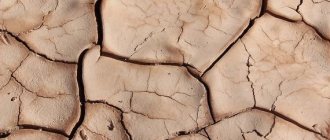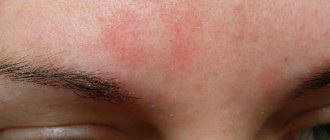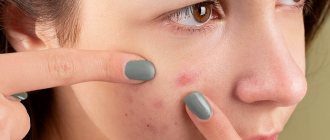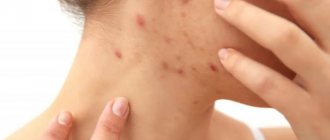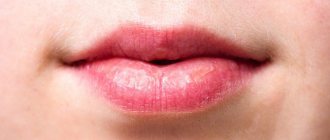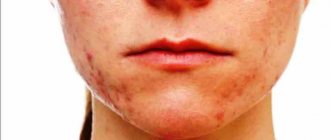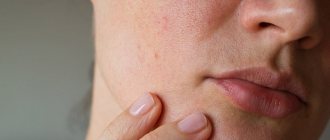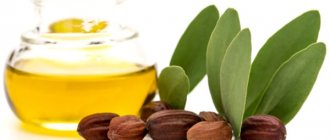Causes of peeling facial skin
In 20% of people, the skin is genetically predisposed to dehydration due to a reduced supply of water and glycerol from the dermis to the epidermis or insufficient synthesis of the protein filaggrin.
Common reasons are:
- Temperature changes, being in a room with dry air
- Seasonal lack of vitamins and minerals
- Illiterate skin care: use of aggressive surfactants, alcohols, etc.
- Improper skin care after cosmetic procedures
- Dehydration, non-compliance with drinking regime
- Dermatological and general diseases (atopic dermatitis, intolerance to certain foods, etc.)
Before starting to correct dry skin, it is necessary to exclude the last possible cause of peeling on the face. It is recommended to visit a dermatologist and therapist to rule out diseases.
Current state of dry skin problem
In recent years, the problem of dry skin has received much attention. Dry skin is characterized by loss of elasticity, more or less pronounced keratosis and peeling of the epidermis, decreased sebum and sweating, and a tendency to cracks. Signs of dry skin include a grayish-white color, rough texture, and emphasized patterns. The main role in the development of dry skin is played by a violation of the skin barrier, the important factors of which are: dehydration and delipidation of the stratum corneum of the epidermis: when the water content in it decreases below 10%, the elasticity of the skin drops sharply and dryness becomes clinically obvious; disruption of the process of keratinization of the epidermis, leading to structural changes in keratinocytes or damaging their connections with each other [1, 2].
There are acquired, constitutional and pathological dry skin. Acquired dry skin is formed when it is exposed to various exogenous factors. Such factors include acute and chronic ultraviolet irradiation, various weather factors (wind, high temperature, low humidity), constant skin care using anionic detergents, solvents and other aggressive substances. Thus, increased skin dryness is observed in people who constantly stay in air-conditioned rooms, characterized by a certain microclimate unfavorable for the skin. Dry skin can also be a consequence of various therapeutic measures. In particular, dry skin is an expected side effect of systemic retinoid therapy. Similar changes are possible with external therapy with retinoids, benzoyl peroxide, azelaic acid, α-hydroxy acids, etc. Dryness, persistent erythema and thinning of the skin can occur in the practice of a dermatologist and cosmetologist as a result of repeated peeling procedures, laser resurfacing, and dermabrasion. A number of experimental studies have found that even short-term (for 3 days) application of a strong external steroid to the skin is accompanied by disruption of the epidermal barrier. By inhibiting the proliferation and differentiation of keratinocytes, glucocorticoids inhibit the formation of lipids in the intercellular matrix of the stratum corneum and reduce the strength of connections between corneocytes by reducing the density and size of corneodesmosomes [1–3].
The constitutional type of dry skin can be physiological or pathological. Physiological dry skin: constitutional dry skin caused by external factors. In particular, it occurs in children from 2 to 6 years of age, when there is a physiological decrease in the production of sebum by the sebaceous glands; Brittle skin is a variant of normal skin that is characterized by increased dryness and thinness. Usually observed in women, it is characterized by increased sensitivity to external influences, frequent occurrence of unstable erythema and rosacea. Dryness of the skin of the face, back, hands, and legs is often recorded in women with white, thin skin, while similar characteristics can be seen in family members. In addition, dry skin can increase and dominate as a symptom complex during aging (senile xerosis). Skin dryness, dehydration, and thinning may occur during menopause and premenopause. The aging process is accompanied by a decrease in the secretion of sebum and sweat, as well as a significant decrease in the production of skin surface lipids, as a result of which a sufficient amount of hydrolipid film is not formed [1, 3, 4].
Pathological dry skin, which occurs with xeroderma, is characterized by dryness and mild, fine pityriasis-like peeling, is observed more often in women and is of genetic origin. Xeroderma in most cases is observed on the face and the extensor surface of the limbs. Xeroderma is accompanied by hypersensitivity and increased irritability in relation to exogenous influences: weather factors, water procedures, cosmetics, as well as a tendency to inflammatory reactions and a decrease in the ability to repair. Even with a slight disruption of the epidermal barrier and an increase in its permeability, epidermal cells begin to produce cytokines to regulate the processes of restoration of the stratum corneum. Research in recent years has convincingly shown that a decrease in the production of skin surface lipids leads to an increase in transepidermal water loss, dryness, and easy rejection of stratum corneum cells in the form of scales - flaking. A number of endogenous and exogenous factors can cause disruption of the hydrolipid balance and integrity of the stratum corneum, leading to the development of increased dry skin. Xeroderma can be one of the symptoms of visceral diseases. It is observed in patients with endocrinopathies (hypothyroidism, diabetes mellitus), chronic intoxication, hypovitaminosis, oncological and hematological diseases, hepatitis, cirrhosis and chronic renal failure. Pathological dry skin in various dermatoses, caused by dysfunction of the skin barrier. Dermatoses in which barrier pathology plays a primary or decisive role in the development of the disease include: irritant contact dermatitis; allergic contact dermatitis; burns; ulcers (ischemic, vascular, diabetic); ichthyosis. Dermatoses in which a primary barrier disruption causes the development of immunological reactions, or, conversely, immunological reactions cause a disruption of the skin barrier, are atopic dermatitis and psoriasis. Immune system disorders may be a cause of barrier pathology in T-cell lymphomas (mycosis fungoides); autoimmune bullous dermatoses; lichen planus [1, 4]. Corneocytes contain the so-called natural moisturizing factor (NMF - Natural Moisturizing Factor). The main components of NMF are free carbolic acids and amino acids, urea, lactates, citrates and minerals. These substances are responsible for the ability of the stratum corneum to retain water and thus maintain the elasticity and firmness of the skin. Studies of the last decade have convincingly shown that the lipid composition of the skin in patients with atopic dermatitis is characterized by a significant decrease in the level and change in the ratio of individual subclasses of ceramides, which are the main components of the intercellular matrix. These data largely explain the significant decrease in the barrier function of the skin in atopic status and the possibility of constant percutaneous penetration of various allergens. The penetration of allergens into the internal environment of the body makes the formation of an allergic response with clinical manifestations in the form of skin disease or systemic sensitization very inevitable or highly probable. Therefore, at present, it is very important to develop methods for the prevention and treatment of allergic skin diseases using methods aimed at limiting the permeability of the epidermis to allergenic influences and restoring the impaired barrier function of the skin [4].
The causes of the symptom complex of skin xerosis are interconnected with four main factors: water deficiency in the stratum corneum, excessively frequent changes of the epithelial layer, disruption of the barrier properties of the skin and a decrease in sebum production. A characteristic sign of dry skin is a lack of moisturizing substances on the surface of the stratum corneum. Water is the main moisturizer of the skin, and when its content decreases, cracks and tears form. For adequate functioning and for the normal condition of the skin, the concentration of water in the stratum corneum must exceed 10%. An increase in transepidermal fluid loss, leading to dry skin, occurs when the permeability of the skin is impaired, and excessive evaporation of water into the atmosphere occurs. An increase in skin permeability may be due to several factors, in particular exposure of the skin to aggressive detergents, acetone and other substances that interact with the skin, as well as frequent bathing. If the skin becomes very dry, its outer layers become thinner and tears may appear. The tears deepen, turning into cracks that become inflamed, causing irritation and itching. Dry skin is most noticeable in areas where there are relatively few sebaceous glands, such as the upper, lower extremities and torso. The cause of xerosis can also be a violation of the secretion of epidermal lipids. Dry skin is a consequence of low water content in the stratum corneum, resulting in excessive desquamation of corneocytes. The moisture content of the stratum corneum depends on the moisture content of the corneocytes located on the surface of the stratum corneum, since the corneocytes of the deeper part of the stratum corneum of the skin contain practically no moisture and are not able to absorb liquid with low osmotic pressure. In dry skin, there are no disturbances in contacts between desmosomes in the superficial areas of the stratum corneum, and the level of desmoglein-1 in the superficial areas of the stratum corneum remains elevated compared with the corresponding indicator in the control group. This is explained by the fact that the function of the enzymes involved in the destruction of desmosomes is impaired when fluid concentrations are insufficient. All this leads to severe desquamation and the appearance of noticeable “clumps” of corneocytes, which make the skin look rough and dry. These accumulations of corneocytes cause the characteristic appearance of the skin - dry or scaly skin. In people with dark skin, desquamation of the stratum corneum leads to changes in skin color - ashen skin almost always means dry skin. The skin barrier is similar to a brick wall, the “bricks” of which are keratinocytes, and the “cement” that binds the cells to each other is the lipids that surround the keratinocytes and form their protective shell. Lipids are oriented bipolarly. The skin barrier performs a number of important functions, in particular, preventing the evaporation of water or the so-called transepidermal fluid loss. In addition, it prevents harmful substances such as allergens and irritants from entering the body. Damage to the skin barrier is one of the factors predisposing to the development of contact and irritant dermatitis. The skin barrier also plays a protective role, preventing the penetration of infectious agents, and this function is determined by the state of the corneocytes of the stratum corneum and the extracellular matrix surrounding them. The moisture content of the stratum corneum of the skin is regulated mainly by the skin's natural hydration factor, which consists of low molecular weight and water-soluble by-products of filaggrin. Corneocytes are anucleate cells whose membrane does not contain lipids. They consist of keratin filaments and filaggrin and are enclosed in a keratinized cell membrane. Filaggrin, also known as filament aggregation protein, plays an essential role in maintaining the barrier function of the epidermis and its hydration. In the deep layers of the skin, filaggrin performs a structural function, but in the superficial layers of the skin it is broken down into amino acids, which have hygroscopic properties and bind tightly to water molecules. Metabolites of filaggrin located in the stratum corneum are histidine, glutamine and arginine. When these amino acids are deaminated, transurocanic acid, pyroglutamic acid and citrulline are formed, respectively. The resulting amino acids are osmotically active substances that regulate skin hydration, and they are NMF. Transurocanic acid, pyroglutamic acid and citrulline, which are derivatives of filaggrin, are involved in the binding of water molecules in the stratum corneum. Other components of NMF are lactic acid and urea, which have hygroscopic properties, as well as inorganic substances such as sodium, potassium, calcium and chlorine ions. These ions are also involved in maintaining the necessary skin moisture. A decrease in NMF content leads to a decrease in the rate of fluid accumulation in the epidermis, which confirms the role of NMF in skin hydration. It should be noted that the composition of NMF changes depending on the season: in winter, the concentration of amino acids increases, while the concentration of lactic acid, potassium, sodium and chlorine ions, on the contrary, decreases. Although there are many NMF stimulating agents on the market today, a substance similar to NMF has not yet been developed. The absence of these substances may be due to the fact that the ratio of NMF components differs in each person and depends on environmental conditions [1, 5–9].
The symptom complex of dry skin is a heterogeneous concept. Comprehensive care for such skin is fundamentally important along with the prescription of pathogenetic therapy.
As is known, the main components of the epidermal lipid barrier are ceramides, cholesterol and free fatty acids. This explains the fact that external agents containing these components in a physiological ratio significantly accelerate the repair of the epidermal barrier. Taking this knowledge into account, Locobase Repea was developed, which contains ceramide III, cholesterol and free fatty acids in a physiological ratio (1:1:1). This product contains 63% lipids and is in the form of a water-in-oil emulsion, which best suits the task of caring for skin prone to extreme dryness.
In addition to essential lipids that restore the structure of the epidermal barrier, Locobase Ripea contains the following components:
- soft white and liquid paraffins, which provide an occlusive effect, forming a waterproof film on the surface of the skin, and reduce transepidermal water loss, which provides rapid relief from dry skin;
- glycerin, which is a hygroscopic hydrant and retains water in the stratum corneum of the epidermis, providing a moisturizing and softening effect;
- solid paraffin nanoparticles, which provide good cosmetic properties and promote the transfer of essential lipids into the deep layers of the epidermis, which determines the duration of action - up to 24 hours (i.e., this product can be applied once a day).
One of the important advantages of Locobase Ripea is the absence of preservatives, dyes and fragrances, which minimizes the risk of developing contact allergic reactions.
The effectiveness of Locobase Ripea has been confirmed in a number of clinical studies, in which, among other things, a decrease in the course dose of topical corticosteroids was noted when they were used in conjunction with this emollient [10–15].
If you do not properly care for dry skin, erythema and peeling may appear, especially after washing, as well as dryness, peeling and small cracks on the red border of the lips and in the corners of the mouth. Subjective sensations of skin tightening, itching and parasthesia also occur. Dry skin is very sensitive to external irritants, especially ultraviolet radiation. Lipids make up approximately 10% of the mass of the entire stratum corneum, but they play a vital role by forming a waterproof barrier. The epidermis is the main structure that synthesizes steroid alcohols and fatty acids, while most of the lipids that make up the epidermis are produced by it itself and do not come from food. Linoleic acid, which is not synthesized by the epidermis, is extremely important, and therefore the level of acid should be maintained through food consumption or local applications. Linoleic acid is part of phospholipids, glycosylceramides, ceramides-1, 4, 9. Compensation for the lack of linoleic acid occurs through the synthesis of oleates, which leads to pronounced disturbances and changes in permeability. Scientific observations indicate that essential fatty acids are essential for maintaining normal stratum corneum structure and function, α-linoleic acid is an omega-3 fatty acid that is found in large quantities in fish oils such as salmon oil or liver oil cod. With a lack of omega-3 fatty acids, no changes in the skin are observed, but these acids play an important role in regulating the inflammatory process [1, 5].
If a patient has dry skin, in order to maintain a normal water-lipid layer, it is necessary to find out what factors cause the dryness. To do this, it is important to assess the condition of other skin parameters. If the patient has dry and sensitive skin, then one can think about weakening the skin barrier and use products containing substances that restore this barrier (cholesterol, ceramides and glycerin). All patients with dry skin should avoid the use of harsh foaming cleansers that remove hydrating lipids and NMF from the skin. These detergents are found in soaps, shampoos, etc., used to wash skin and hair; they are also found in laundry detergents and dishwashing detergents. Patients with dry skin should avoid long baths, especially with hot or chlorinated water. In addition, people with very dry skin in low humidity environments can use humidifiers and apply moisturizers two to three times a day and after bathing. Regular soap should not be used to wash dry skin. Only syndets (synthetic detergents) with oil components (fatty acids, glycerin and oils) and very moderate surfactants are recommended. After washing, the skin should be thoroughly, but not roughly, rinsed to remove all remaining surface detergents [1, 5, 6].
Skin hydration can be enhanced by increasing the retention of external water in the stratum corneum by using humectants and slowing down the evaporation of water through the stratum corneum by applying an occlusive lipid film. Lipids in this case can reduce delipidation of the epidermis associated with dry skin and protect it from external irritants. Skin hydration products should use both principles, but take into account the skin type and the conditions under which the products are used. During the winter season, skin hydration products will include moisturizers, but the emphasis should always be on the presence of a protective opaque film. In summer, the approach should be different, in particular, the use of comedogenic lipids should be avoided. In addition to identifying and eliminating the causes of dry skin, a large number of moisturizing creams are used. These products, according to their mechanism of action, are divided into moisturizers, occlusives, and emollients (emollients) [1, 5].
In fatty water-in-oil creams, droplets of liquid (dispersion phase) are distributed in fat (dispersion medium). Typical emulsions of this type are cow's milk, lanolin, and lime liniment. Creams of the “water in oil” type are used: 1) for severe dry skin, decreased elasticity and minor superficial inflammatory phenomena - they are the main dosage form recommended for patients with atopic dermatitis; 2) when the keratinization process is disrupted, for example in patients with all clinical types of ichthyosis.
Keratolytic substances are used to treat hyperkeratosis, which is often observed with dry skin and xeroderma (ichthyosis). Salicylic and lactic acids and organic α-hydroxy acids (glycolic, malic, pyruvic, citric and glycuronic) in the form of emulsions or creams, propylene glycol (can also be used with salicylic acid), urea [1, 5].
It should be remembered that modern care for any skin type should include two main effects: gentle cleansing and adequate moisturizing. Cleansing dry skin can be achieved in different ways. The method of cleansing the skin using various cleansing creams or emulsions has been widespread for many decades. These are mainly cold creams (English cold-cream, literally cold cream), which contain various waxes, mineral oils, and borax as an emulsifier. Such creams are usually applied with your fingers and spread evenly over the entire affected surface of the skin. They can be removed using a soft cloth or cotton swab, or washed off with water. The mineral oils that make up these creams play the role of unique solvents that can dissolve decorative cosmetics (in the case of cleansing facial skin) and exogenous pollution. More modern dry skin cleansers include non-ionic detergents such as fatty acid esters and micelles and other substances. Such ingredients have been shown to create a cleansing emulsion with a lighter texture. In addition, they are able to provide high-quality cleansing of the skin without removing natural lipids from its surface, such as ceramides and cerebrosides. That is why these emulsions are most popular for cleansing dry and very dry skin, the genesis of which is often noted to be a lack of lipids between the scales in the stratum corneum. Manufacturers of the highest quality dry skin cleansers include the missing lipids to create a protective film on the surface of the stratum corneum. In particular, many modern emulsions for skin cleansing include fatty acid esters, wax esters, ceramides or cerebrosides. Adequately cleaning dry skin is extremely important. The use of detergents and emulsions containing anionic detergents not only increases skin dryness, but also increases its permeability to various substances, including allergens, that subsequently enter the skin. For example, it has been shown that intolerance to certain moisturizers containing retinol palmitate was directly related to the quality of the cleanser patients used before applying the moisturizer. In addition, microcracks that appear on the surface of dry skin can serve as entry points for secondary infection [3].
Accordingly, the most important task at present is the selection of modern detergents that can provide optimal skin cleansing, on the one hand, and do not damage the lipids of the stratum corneum, on the other.
The second important step in caring for dry skin is adequate hydration. Currently, there are three groups of substances that have a moisturizing effect. Firstly, these are the so-called humictants, secondly, film-forming substances, and thirdly, keratolytic agents. Humictants allow water found in the stratum corneum to be introduced deep into the skin. Modern humictants include NMF, polyols (glycerol, sorbitol, propylene glycol), macromolecules (glycosoaminoglycans, collagen, elastin, DNA) and liposomes. The NMF system includes various water-soluble and hydrophilic substances produced in the stratum corneum from cell membrane lipids. Its main representatives are pyrrolidonecarbolic acid, urea (at a concentration of up to 10%) and lactic acid (at a concentration of 5–10%). Skin hydration is also achieved by reducing transepidermal water loss. This is possible by applying a film consisting of lipids to the surface of the stratum corneum. Film-forming substances include substances that make up the oil phase of any emulsion (cream). Vaseline, paraffin, perhydrosqualene, various silicones, natural oils rich in polyunsaturated fatty acids (fish oil, primrose, grape seeds, etc.), wax, lanolin, and some fatty alcohols are currently used as the oil phase. The use of various keratolytic agents is an additional way to moisturize the skin. As a rule, these substances are used for hyperkeratosis accompanying xerosis of the skin, in particular, for ichthyosis. Currently, keratolytics are widely prescribed in cosmetology for skin peeling procedures, one of the goals of which is rejuvenation. Modern care products include salicylic acid, hydroxy acids, urea (in concentrations above 10%), propylene glycol [3].
Thus, the symptom complex of dry skin is a heterogeneous concept, and comprehensive care for such skin, including gentle cleansing and moisturizing, is fundamentally important along with the prescription of pathogenetic therapy, which is especially important for such vulnerable places from the point of view of susceptibility to irritation as the skin of the hands, face and lips, which ultimately improves the quality of life of patients with problematic xerotic skin.
Literature
- Rodionov A. N. Dry skin. Dermatocosmetology. Lesions of the facial skin and mucous membranes. Diagnosis, treatment and prevention. SPb: Science and Technology. 2011. 911 p. pp. 63–69.
- Yusupova L. A. Dry skin: a modern view of a clinician // Medico-pharmaceutical bulletin of the Volga region. 2013. No. 4. pp. 13–14.
- Arabian E. R., Sokolovsky E. V. Dry skin. Causes of occurrence. Principles of correction // Journal of dermatovenereology and cosmetology. 2002, no. 1. pp. 23–25.
- Kochergin N. G., Belousova T. A. Problems of dry skin therapy // Attending Physician. 2009. No. 8. pp. 15–19.
- Bauman L. Cosmetic dermatology. Principles and practice. Per. from English Potekaeva N. N. M.: MEDpress-inform. 2012. 688 p.
- Barcoa D., Gimenez-Arnaub Xerosis A. A dysfunction of the epidermal barrier // Actas Dermosifiliogr. 2008. No. 99. R. 671–682.
- Chamlin S., Kao J., Frieden L. et al. Ceramide-dominant barrier repair lipids alleviate childhood atopic dermatitis: changes in barrier function provide a sensitive indicator of disease activity // J Am Acad Dermatol. 2002. No. 47. R. 198–208.
- Elias PM Stratum corneum defensive functions: an integrated view // J Invest Dermatol. 2005. No. 125. R. 183–200.
- Macharadze D. Sh. Skin xerosis: a problem of dermatology // Attending Physician. 2006. No. 9. pp. 15–19.
- Kucharekova M., Schalkwijk J., Van De Kerkhof P. S. et. al. // Contact Dermatitis. 2002. V. 46. No. 6. P. 331–338.
- Berardesca E., Barbareschi M., Veraldi S., Pimpinelli N. // Contact Dermatitis. 2001. No. 45. P. 280–285.
- Kawashima M. // Skin Research. 2002. No. 1. P. 338–346.
- Tikhomirov A. A., Gamayunov B. N., Korotkiy N. G. // Questions of practical pediatrics. 2009. T. 4. No. 4. pp. 21–25.
- Elisyutina O. G., Lapshin N. N., Filimonova T. M. et al. // Russian Allergological Journal. 2009. No. 4. pp. 75–81.
L. A. Yusupova*, 1, Doctor of Medical Sciences, Professor N. I. Mingazetdinova**
* GBOU DPO KSMA Ministry of Health of the Russian Federation, Kazan ** Clinic “Hanbike”, Kazan
1 Key information
External and internal manifestations of dry skin
External signs : fine-plate peeling, most often occurs in areas with thinner skin - the area around the mouth, nasolabial fold and eyelids. Redness and a feeling of tightness may appear. In advanced cases, itching and the addition of a secondary infection - pustules.
What's inside the skin?
Peeling and dry skin is a violation of the moisture-retaining function of the stratum corneum, which is provided by:
- Sebum . Peeling often bothers people with anatomically dry skin types.
- Lipid substance of the epidermis
- Natural moisturizing factor components (amino acids, urea, lactic acid)
- Keratin is a protein that fills keratinocytes. It is insoluble, but swells in water, binding its molecules
Violations of these structures lead to the formation of dryness, tightness of the skin, and later to peeling.
Influence of the external environment
People with inherently dry skin are susceptible to environmental factors. For example, in winter, in the wind, the delicate skin around the eyes very quickly begins to peel off. This happens due to the fact that the thickness of the skin in this area is very small. In this case, a moisturizing and nourishing cream will help cope with the cosmetic defect, which is used not only at night, but also under makeup before going outside. In this case, all layers of the skin will receive a sufficient amount of nutrients. The cream film also creates an additional protective barrier that will help prevent the negative impact of aggressive weather conditions on the delicate skin around the eyes.
